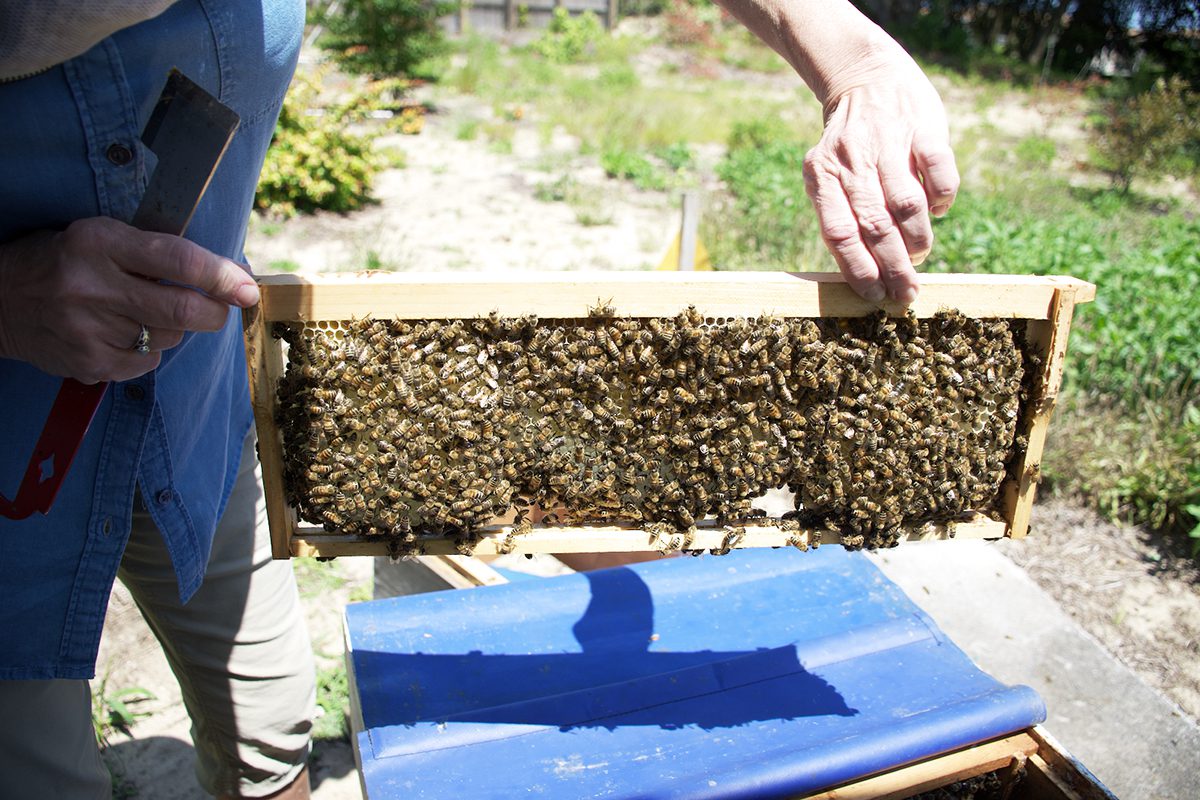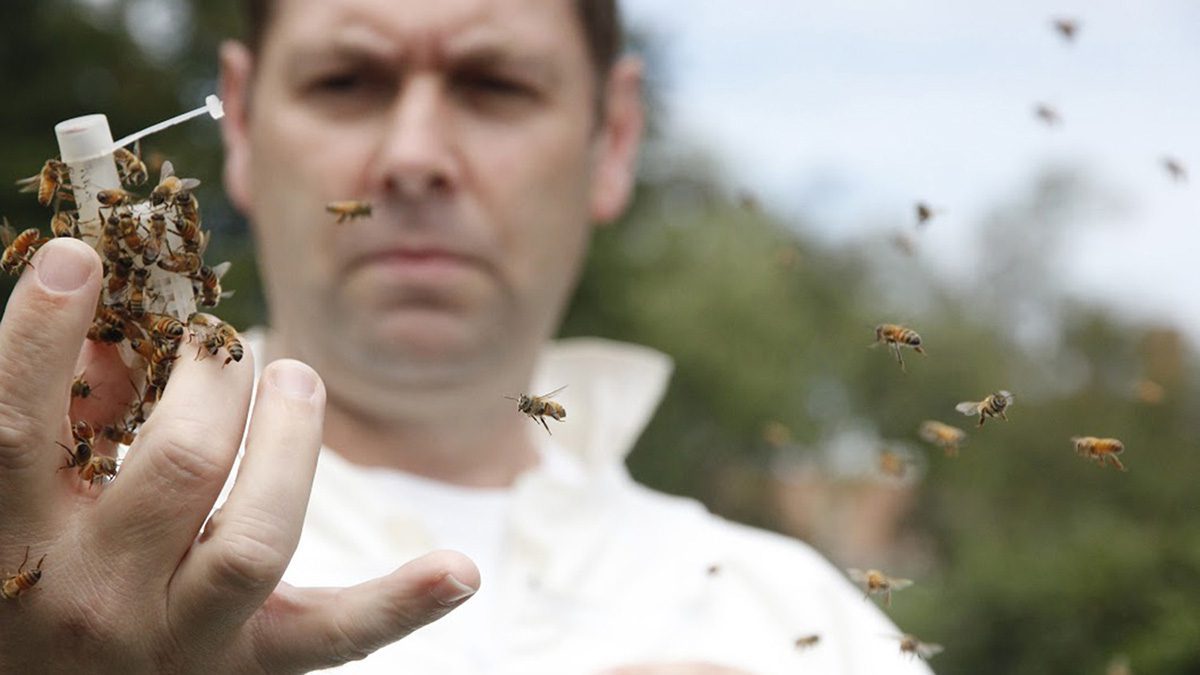
Last in a series on pollinators.
KITTY HAWK — Denise Deacon inspects her bees. This year she only has one hive, although in years past she has had more — as many as eight.
Supporter Spotlight
She gently pries the lid off and points to the dark brown resin that lines the top of the inside of the hive.
“That’s the propolis,” she says, explaining that it’s resin the bees collect from trees and other plants that they use to weatherproof the hive.
She slides a frame out and looks at it critically. It’s still early in the season for honey production — they’ll get around to that later in the summer. Right now, the bees are concentrating on foraging for food, building the hive and reproduction.
The bees in this frame have been working on the honeycomb for some time and the comb fills almost the entire frame.
She pulls out another frame and in this frame the honeycomb is clearly a work in progress, the comb filling perhaps a third of the frame. Each cell appears to be identical, although they are not. The largest are reserved for the drone bees, smaller ones for workers and the queen bee gets her own shape and size.
Supporter Spotlight
The comb, the wax the bees produce to seal the honey in the combs, and the honey are unique to the honeybee. Other bees die off in the winter and emerge as the weather warms. Honeybees stay active in their hive all winter and the honey is their food source.
They produce more honey than they need for the winter, although beekeepers vary in how much honey they’ll harvest. Some, like Deacon, leave enough honey for the hive to get through the winter. Others take all the honey and feed the bees sugar water as a substitute.
“Some people do take off honey and then feed them sugar water, to make it through the winter. They will survive but they won’t be as healthy is my understanding,” she said.
This is Deacon’s 10th year raising her own bees, although the idea had been in the back of her mind since childhood and the onetime attempt by her father.
“In my teens, my father started beekeeping,” she recalled. After a weekend away, “We came back and the house had been broken into and they had kicked over the beehive. He didn’t continue from that point forward. (But) that was just something in the back of my mind that might be a cool thing to do.”

She is a member of the Outer Banks Beekeeper’s Guild, one of the founding members, although she downplays that role.
“In my mind. I may have made phone calls to people to say, ‘Hey, let’s get together and talk about getting a group together,’” she said.
The guild is part of the North Carolina State Beekeepers Association, an amateur beekeeping organization that may be the largest in the country.
“We do have the largest state (bee) association, with nearly 5,000 paid members,” said Dr. David Tarpy, apiculture professor and extension specialist at North Carolina State University. “Compared to even large states like California and Texas (we have) more beekeepers. In Texas and California, those are large-scale commercial guys so they have more colonies but fewer beekeepers.”
There are some large commercial beekeeping operations in the state, but Tarpy, when comparing North Carolinas commercial beekeepers to other states, said they are, “vanishingly small.”
The number could be fewer than a dozen.
Not all the commercial operations take place in the state; they are, in fact, somewhat migratory.
“There are large-scale beekeepers that reside here full time and go out to California every winter for the almonds and up to Maine for the blueberries and things like that,” he said.

There are 4,000 or so species of bees that live in the United States, according to the U.S. Geological Survey, and the honeybee is not even native to the continent. The first shipment of honeybees arrived in the Virginia Colony in early 1622. By the end of the 17th century, they were part of everyday life, although beeswax was the more valuable commodity at that time.
As an introduced species, there is controversy surrounding honeybees. Deacon pointed out that even her lone hive could have an effect on the local ecology.
“The problem with honeybees, you’re bringing 40,000 insects into this realm of 3 to 5 miles and all these other native bees that are all out there competing for the same plants,” she said.
Tarpy sees the issue of competition with native species as overblown and, perhaps, one that misses more significant questions.
“Whatever competition has happened, it’s been going on for 400-plus years. Ecology responds a lot faster than that,” he said. “There probably has been competition and certainly when beekeepers move their hives into a very fragile area like a desert, they can swamp whatever species are there. So it certainly is an issue and one we need to be cautious about. But is it driving the extinctions of these other bees? I think there are bigger fish to fry for that: pesticides, those kind of things.”
The pollinator population in general is under stress. And, although careless pesticide use does threaten honeybees, the most significant natural peril is the varroa mite.
It is not the mite itself, though, that is the threat, rather it is the disease the mites carry.
“I would say that public enemy No. 1, 2, and 3 are all called the varroa mite,” Tarpy said. “They’re like little vampires, sucking the bees until they’re so anemic that other stressors start to compound. But the biggest thing that we’re actively researching is that it’s not really the varroa mites that kill bees. It’s the viral pathogens that they’re vectoring. They’re like little dirty hypodermic syringe needles.”
There is no easy way to protect bees from varroa mites. The N.C. State Apiculture Program is concentrating on two areas of research: strengthening hives so they can better withstand stress and early detection of infection.
“We offer this service that if you send in your bees, we can … look at all of these different pathogens and see if we can identify if you have an overwhelming pathogen load within the colony,” Tarpy said.
Tarpy’s research is finding ways to identify the strongest queen for a colony. The apiculture lab has developed empirical measurements that can be applied to queen bee health, and Tarpy’s research has shown healthy queens correlate to a healthier hive.
“If you have a bad queen, your ceiling is low. If you have a good queen, your ceiling is high. The queen is this singular thing that beekeepers have control over,” he said.
The work is currently conducted in a dilapidated building on the N.C. State campus.
“Research is being conducted in one of the worst facilities in the University of North Carolina system,” according to the North Carolina State Beekeepers Association’s website. “There is inadequate room for instruction, storage and research … The teaching classroom is in the former kitchen and dining area where long leak stains adorn the sheetrock ceiling. During rain showers, buckets are strategically placed in order to catch rain water that drips through the sheetrock.”
The association lobbied state legislators for funds to replace the building and the North Carolina General Assembly responded in 2019 with $4 million for a new apiculture center.
“We’re on the downhill slope of the design phase, which is the fun part for me because we get to decide what kind of rooms we want, what we’re going to put in it and how we’re going to use it. We’re building this facility exactly the way that it would really work well for apiculture, science and extension. It’s having all the elements that we could ever want,” Tarpy said.
Construction is estimated to be completed in August 2024.







